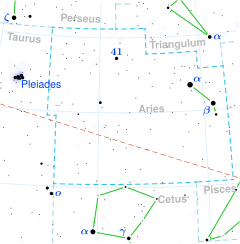Iota Arietis, Latinized from ι Arietis, is the Bayer designation for a binary star system in the northern constellation of Aries. It has an apparent visual magnitude of 5.117;[2] bright enough to be dimly seen with the naked eye. Parallax measurements made during the Hipparcos mission yield an estimated distance of 520 light-years (160 parsecs) from Earth.[1] The variable radial velocity of this system was announced by W. W. Campbell in 1922. K. C. Gordon published orbital elements for this single-lined spectroscopic binary system in 1946, giving an orbital period of 4.29 years and an eccentricity (ovalness) of 0.36.[7]
| Observation data Epoch J2000.0 Equinox J2000.0 | |
|---|---|
| Constellation | Aries |
| Right ascension | 01h 57m 21.05476s[1] |
| Declination | +17° 49′ 03.1202″[1] |
| Apparent magnitude (V) | 5.117[2] |
| Characteristics | |
| Spectral type | K1p[3] or G8III[4] |
| U−B color index | +0.700[2] |
| B−V color index | +0.921[2] |
| Astrometry | |
| Radial velocity (Rv) | −4.9[5] km/s |
| Proper motion (μ) | RA: +34.76[1] mas/yr Dec.: −22.95[1] mas/yr |
| Parallax (π) | 6.27 ± 0.33 mas[1] |
| Distance | 520 ± 30 ly (159 ± 8 pc) |
| Absolute magnitude (MV) | −0.4[6] |
| Orbit[7] | |
| Period (P) | 1,567.66±0.62 d |
| Semi-major axis (a) | ≥ 217 Gm (1.45 AU) |
| Eccentricity (e) | 0.356±0.022 |
| Periastron epoch (T) | 2,420,961.1±27.2 JD |
| Argument of periastron (ω) (secondary) | 94.04±4.72° |
| Semi-amplitude (K1) (primary) | 10.78±0.31 km/s |
| Details | |
| Mass | 3.17[8] M☉ |
| Radius | 20[8] R☉ |
| Luminosity | 240[8] L☉ |
| Surface gravity (log g) | 2.60[9] cgs |
| Temperature | 5,031[8] K |
| Metallicity [Fe/H] | −0.10[9] dex |
| Rotational velocity (v sin i) | 3.33[9] km/s |
| Other designations | |
| Database references | |
| SIMBAD | data |
For the visible component, in 1952 N. G. Roman found a stellar classification of K1p, where the 'p' indicates some type of peculiarity with the spectrum. Her comments indicated that the "Hydrogen lines and λ 4290 are strong enough to indicate a class II star, but the CN is barely strong enough for class III, and the Sr II is not much stronger than this would require.".[3] E. A. Harlan published a class of K peculiar in 1969, commenting, "Hδ strong, Fe I λ4045 is weak for type".[11] In 1990, K. Sato and S. Kuji gave a class of G8III, suggesting this is an aging G-type giant star and questioning its peculiar status.[4] Bayesian inference of the stellar properties indicates this star is on the horizontal branch.[8] The companion is a suspected white dwarf.[12]
